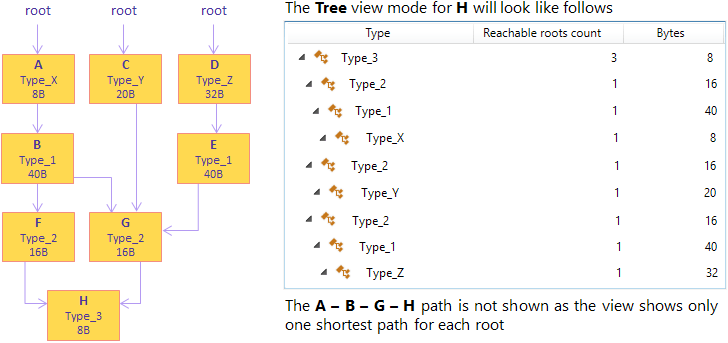Shortest Paths to Roots
The Shortest Paths to Roots group of views shows shortest paths to an instance from application's roots: one shortest path for each root.
For convenience, dotMemory presents paths in two ways: as a plain list (Shortest Paths) and as a tree (Merged Shortest Paths ). To select a certain way, click the corresponding button in the list of views.
Use the views to inspect instance's retention paths and identify what prevents the instance from being collected. This can be very useful when investigating not exclusively retained objects (see Group by Dominators for details).
Shortest Paths
For each path to roots, dotMemory shows the plain list of objects that reference the instance starting with an app's root. This can be useful when you want to examine the entire retention path.
To switch between paths, use the arrow buttons < > on the top of the list.
The list of paths consists of the following columns:
| Name | Description |
|---|---|
| Field name | The name of the field through which an instance is retained. |
| Type | Type name. |
Merged Shortest Paths
All paths to roots are shown in one expanding list. The list starts with the instance and descends to app's roots. This may be useful when you don't want to drill down the full retention hierarchy but just want to identify the closest object that holds the instance in memory.
The list of paths consists of the following columns:
| Name | Description |
|---|---|
| Type | Type name. |
| Reachable roots count | The number of roots that can be reached from a certain instance. |
| Bytes | The size of a certain instance in bytes. |
Example

Selecting objects for further analysis
In the Shortest Paths to Roots view, you can select the following subjects for further analysis:
To select a particular instance
Do one of the following:
Double-click the instance in the list.
Right-click the instance and choose Open this instance.
After this, the Shortest path to root subject is added to the Analysis Path and you can use specific instance views to analyze the instance in more details.
To select the objects that are exclusively retained by the analyzed objects set
Click the
 Open objects retained by this set button.
Open objects retained by this set button.After this, the Exclusively retained objects subject will be added to the Analysis Path and the list of desired objects will be displayed in the Group by Types view.